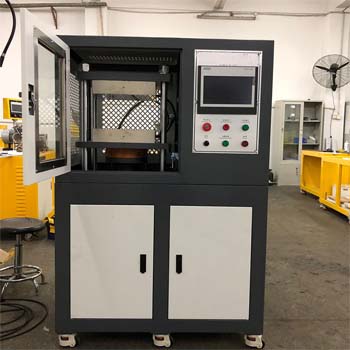In the rubber and polymer industry, vulcanization is a chemical process that enhances the natural rubber into a more durable, elastic, and heat-resistant material.
This vulcanization process solve the limitation problem of raw rubber, such as stickiness in heat and brittleness in cold, which make the raw rubber material are suitable for diverse industrial applications.
Lab vulcanizer press equipment generally consists of: Heated platens , Hydraulic press system ,Temperature and pressure controls,Timer system for cycle management . It is a compact, precision-engineered machine used in laboratories to simulate the vulcanization process on a small scale.
The Lab vulcanizer press machines are great to create test sheets or small rubber specimens for physical property testing, quality control, and formulation development.
A lab vulcanizer press is an essential tool in research and development (R&D) settings, which help engineers and chemists to test and optimize rubber formulations before scaling up to full production.
How Does Vulcanization Process Work ?
1. Preparation of Rubber Compound
Before pressing, the rubber compound is mixed with various ingredients, including sulfur (for vulcanization), accelerators, fillers, and plasticizers. This mix is known as the “rubber compound” or “rubber stock.”
2. Mold Setup
The rubber compound is placed into a heated mold. This mold is typically made of steel and designed in the desired shape of the test sample or final part.
3. Loading Material Between Plate of Vulcanizer Press
The mold is placed between the two plate of the lab vulcanizer press equipment. The two layer plates are pre-heated to a set temperature—commonly between 140°C and 180°C, depending on the rubber type and formulation.
4. Pressing and Vulcanization
Once the rubber material come to position, the hydraulic system applies pressure (often up to several tons) and maintains it for a specified curing time—usually appro 6 to 18 minutes.
On the vulcanization process ,it is crical to add additives in the form of accelerators, activators, and retarders is vital to supplement the process. This makes the vulcanization curing process more efficient even at lower temperatures. The combination of heat and pressure triggers a chemical cross-linking process, which is the reaction mechanism that gives vulcanized rubber its tensile strength. The crosslinking make the raw rubber become much more hard and cannot be broken down easily at all. Basically ,the cross-links formed depend on the amount of vulcanizing agent, reaction time, temperature, and the nature of the rubber itself. sulfur alone does not offer a speedy process.
5. Cooling and Demolding
After curing, the mold then need to be cooled . The cured rubber is then removed from the mold for further testing or use.
In conclusion ,vulcanized rubber is commonly applied in many application which require the rubber material to withstand stress ,such as automotive ,aerospace and industrial equipment. Through vulcanization ,it improve the performance and langevity of rubber ,and thus make it essential in products like tires ,seal ,hoses,o-ring ,shoe soles and gaskets etc .







